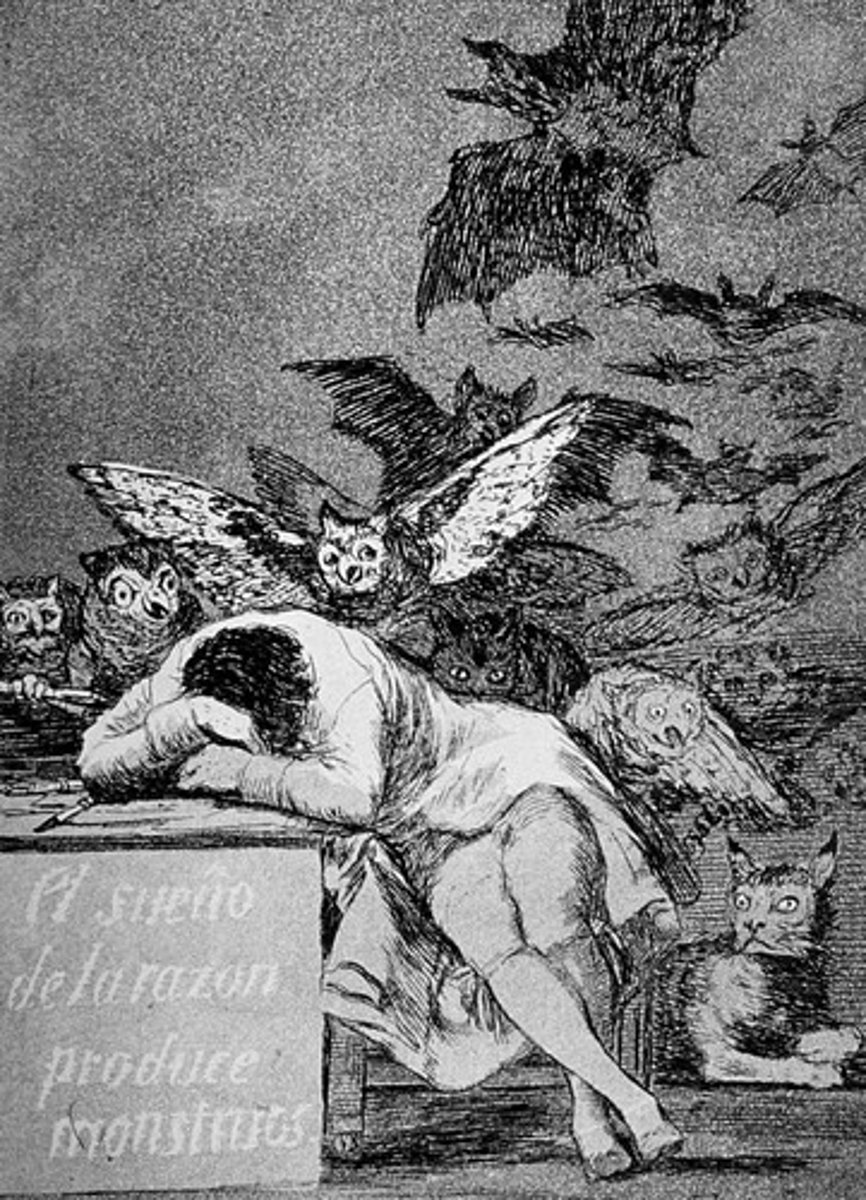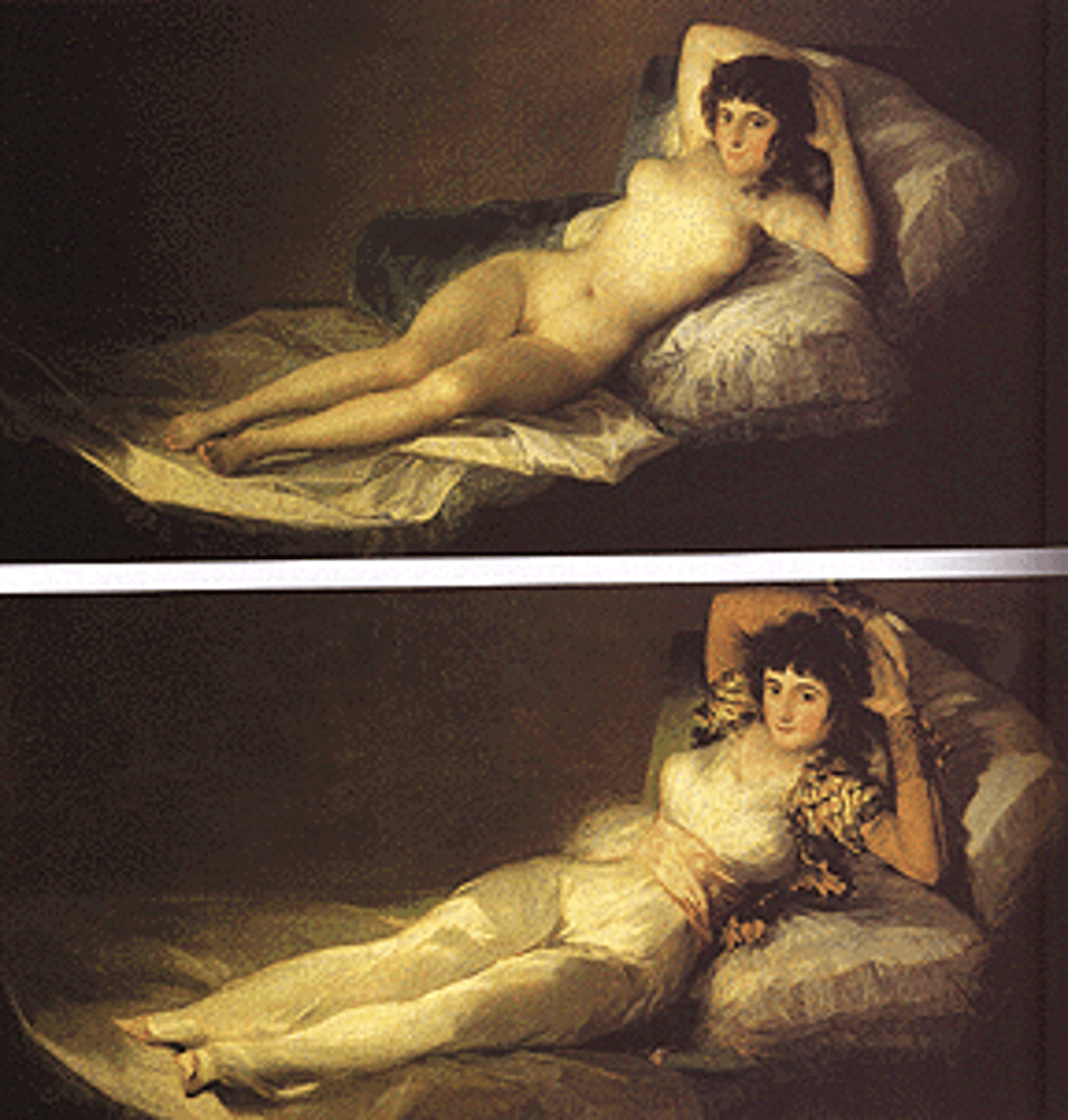APUNTES: Francisco de Goya
1/37
There's no tags or description
Looks like no tags are added yet.
Name | Mastery | Learn | Test | Matching | Spaced |
|---|
No study sessions yet.
38 Terms
¿Quién fue Francisco de Goya y Lucientes de el Siglo XVIII [1746-1828]?
(who was Franciso de goya and luciente of the 18th century)?
Francisco José de Goya y Lucientes fue un pintor y grabador español. Su obra abarca la pintura de caballete y mural, el grabado y el dibujo.
Francisco de Goya and Lucientes was a painter and engraver. His work encompasses easel and mural painting, engraving and drawing.
Se retiró de la vida pública en ____
Trabajó para él mismo y para sus amigos
He retired from public life in ____
and worked for himself and his friends
1815
Franciso José de Goya y Lucientes was born in
Fuendtodos [a small Spanish town where barely 178 people live]
but her slides say Aragón, which is a landlocked region in northeastern Spain comprising the provinces of Huesca, Zaragoza
Franciso José de Goya y Lucientes was born on
March 30, 1746
30 de marzo de 1746
Franciso José de Goya y Lucientes died on
April 16, 1828
16 de abril de 1828
Francisco lived in Spain most of his life, and his Spanish royal patronage continued under Charles IV and Ferdinand VII, but
in 1824, he left Spain for Bordeaux/Burdeos (France), where he died.
Hizo su aprendizaje en ____
(He did his apprenticeship in ____)
Zaragoza
Trabajó en _____ como pintor de la corte
He worked in _____ (Spain's central capital) as a court painter
Madrid
Fue a Italia en ____
(He went to Italy in) ____
1770
Regresó a Zaragoza in ____
(He returned to Zaragoza in) ____
1771
Se trasladó a Madrid en ____
He moved to Madrid in ____
1775
Hizo cartones para los tapices de ______
made cartoons for tapestries from ______
1775-1792
Era un Pintor de cámara de Carlos IV en ___
He was a court painter to Charles IV in ___
1789
Se enfermó en ____
He fell ill in ____
1792
Él empezó con lo extraño en ____
He began with the strange" in _____
1793
"Los caprichos" son
The caprices" are
los aguafuertes y son satíricos
82 aguafuertes con macabres y brujas
the etchings and they are satirical with 82 ghoulish/spooky/creepy etchings with witches. (The drawings look like monsters)

Macarbes
means "having the quality of having a grim or ghastly atmosphere". The macabre works to emphasize the details and symbols of death. The term also refers to works particularly gruesome in nature.
Más en Los Caprichos (The Caprices)
More info on Los Caprichos
Goya put the ugliness of society (corruption, superstition, greed, folly, and nightmares) in stark contrast with the new reality and took stock of the follies that undermined the establishment of reason in the Age of Enlightenment in his 80 etchings known as Los Caprichos (The Caprices). .
Why did Goya make Los Caprichos
The prints were an artistic experiment: a medium for Goya's condemnation of the universal follies and foolishness in the Spanish society in which he lived.
The Caprices or Los Caprichos is controversial because it
depicted a wide variety of subjects including the clergy, prostitutes and witches.
The two techniques used in making Los Caprichos is
etching and aquatint.
Etching
traditionally the process of using strong acid or mordant to cut into the unprotected parts of a metal surface to create a design in intaglio in the metal. In modern manufacturing, other chemicals may be used on other types of material.
Aquatint
a printmaking technique that produces tonal effects by using acid to eat into the printing plate creating sunken areas which hold the ink.
Cómo se sentía Francisco de Goya sobre la familia de Carlos IV y su posición en su arte
(How Francisco de Goya felt about The family of Charles IV and their position in his art)
1799 - 1800
La familia Real (The Royal Family)
Pensaba que eran muy débil (Thought they were very weak)
Satírico (Satirical)
"La maja vestida" y "La maja desnuda" ("The Clothed Maja" and "The Naked Maja)
Se consideraba escándalosa ("Was considered scandalous)
Fue secuestrada durante la Inquisición (was kidnapped during the Inquisition)

Bajo Joseph Bonaparte (______) Goya se quedó como pintor de la cámara pero no pintó retratos oficiales
Under Joseph Bonaparte (______) Goya remained as a painter of the camera but did not paint official portraits
1808-1814
Había aborrecimiento de regla extranjera (foreign rule) en ____
There was an abhorrence of foreign rule (foreign rule) in _____
1814
Cuando ______ tomo poder
Exonerado de cargos
Goya pintó "El 2 de mayo" y "El 3 de mayo" para el Rey
When ______took power
Goya was Exonerated on all charges
He painted "on May 2" and "on May 3" for the King
Fernando VII

Se enfermó en ___
He got sick in ___
1819
Él pintó "Pinturas negras" en ___
He painted "Black Paintings" in ___
1820
En total, pintó ____ pinturas, ____ aguafuertes, y ____ de dibujos
In total, he painted ____ paintings, ____ etchings, and ____ of drawings.
500; 300; 100s
Estudió en ____ - hizo mucho por su reputación
He studied in ____ - he did a lot for his reputation
Roma/Rome
Francisco de Goya era
Francisco de Goya was
el más agudo retratista de su tiempo
the sharpest portrait painter of his time
Era un hombre sincero pero
Tuvo una serie de crisis que contribuyeron a tensión emocional y mental
Su sensibilidad se rompió en el ambiente trágico
He was a sincere man but
His sensibility was broken in the tragic atmosphere
He had a series of crises that contributed to emotional and mental strain
Su trabajo extendió sobre __ años, que era muy raro en ese tiempo
His work extended over __ years, which was very rare at that time
60
Sus maestros:
His teachers:
Velázquez, Rembrandt, y la naturaleza (según él)
Velázquez, Rembrandt, and nature (according to him)
Su arte consiste de __ etapas que corresponden a circunstancias en su vida
His art consists of __ stages that correspond to circumstances in his life
4
PRIMERA ETAPA de ______
FIRST STAGE in/from ______
1746 - 1792
Aceptó el mundo cómo era
Pintó cartones para tapices
Tenía Diversiones cotidianas, dibujos sencillos con colores brillantes
La gallina ciega
El cacharrero
El quitasol - cartón para tapiz, comisionado por Carlos III
Fuertes diagonales - composición triangular
Más tarde usaría contrastes más sutiles y estructuras más rígidas
Es un retrato poético
Ejemplo de la alegría (joy) de la vida
He accepted the world as it was
He painted tapestry cartoons
He had everyday amusements, simple drawings with bright colors
The Blind Hen
The Potter The Parasol - cardboard for tapestry, commissioned by Charles III
Strong diagonals - triangular composition
Later hewould use more subtle contrasts and more rigid structuresIt's a poetic portraitExample of the joy of life